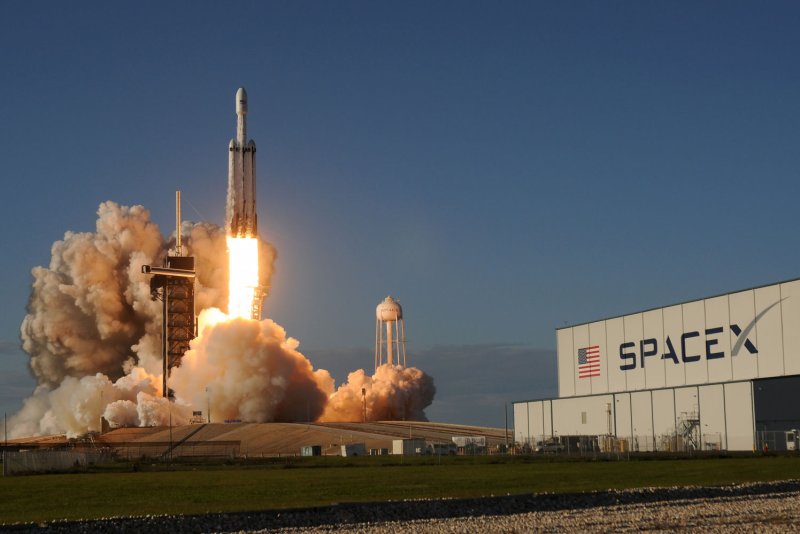1 of 10 | A SpaceX Falcon 9 Heavy rocket launches at 6:35 PM from Complex 39A at the Kennedy Space Center, Fla. on Thursday. Photo by Joe Marino-Bill Cantrell/UPI |
License Photo
CAPE CANAVERAL, Fla., April 11 (UPI) -- SpaceX's Falcon Heavy rocket lifted off on schedule at 6:35 p.m. Thursday from Florida's Kennedy Space Center, the second launch for the biggest rocket in use today.
The rocket carried the ArabSat 6A communications satellite for a Saudi Arabian company. As the first commercial payload for Falcon Heavy, the launch opens a new era for the private space industry and expands SpaceX's dominance in the industry.
Two side booster rockets flew back and landed at Cape Canaveral, creating sonic booms heard as far as Orlando. A third booster landed on a barge in the ocean, something SpaceX hadn't accomplished with the previous Falcon Heavy launch. The boosters will be refueled and reused.
SpaceX CEO Elon Musk tweeted in celebration "The Falcons have landed," with photos of all three recovered boosters.
The satellite was safely deployed in orbit just more than half-hour after launch, giving SpaceX a flawless launch.
The launch had been delayed three times during the week, mostly due to a storm front and upper-level winds.
With the successful launch Thursday, another Falcon Heavy launch is expected to carry dozens of military and scientific research satellites into space in June for the U.S. Air Force's Space Test Program-2, according to space industry publication Spaceflight Now.
The Falcon Heavy is the world's tallest and most powerful rocket in use. Thursday's launch marks the first time a Block 5 booster was used for the big rocket. The Block 5 is the latest-generation Falcon rocket, intended to be reused numerous times with minimal refurbishment.
The next SpaceX mission from Florida, CRS-17, was recently announced for 5:55 a.m. April 26. That will be a single Falcon 9 carrying supplies and research experiments to the International Space Station via the Dragon cargo spacecraft.
Thursday's launch brought crowds of spectators to the Titusville and Cocoa Beach areas, many of whom had waited to see liftoff on previous days, only to be disappointed.
Paul Niedermann of Rockford, Ill., was among those who made a special trip to Florida to see the launch. He paid $195 for NASA's best tickets to the launch, which get spectators about 4 miles from the launch pad.
"I arrived on Sunday knowing there can be delays. So I'm to be here today before I have to fly back to Illinois," said Niedermann, an aerospace engineer. "I believe we are entering a new dawn, Space Age 2.0 if you will, and I'm more motivated than ever to witness this for myself."
On Falcon Heavy's maiden voyage into space in February 2018, an estimated 100,000 visitors came to watch. That launch was the biggest rocket since the Saturn era ended in the 1970s. It was carrying Elon Musk's red Tesla Roadster with the crash dummy Starman at the wheel.
Development of the Falcon Heavy, like all of SpaceX's missions, has been described by SpaceX founder Elon Musk as a step toward his goal of sending people to Mars.
A launch on a Falcon Heavy carries a price tag of $90 million, compared to competitor United Launch Alliance's Delta IV Heavy, which costs more than $300 million. Falcon Heavy is taller than the shuttle launch rocket was, but carries a little less thrust or power.















